Experimental and Numerical Investigation of the Thermal and Force Regulation Mechanism of Bypass Coupling Double-Sided Arc Welding Based on 6061 Aluminum Alloy
Abstract
:1. Introduction
2. Experimental and Calculated Details
2.1. Experiment Set-Up
2.2. Simulation Procedure
2.2.1. Basic Assumptions and Control Equations
2.2.2. Boundary Conditions
2.2.3. Numerical Calculation Method
3. Results and Discussion
3.1. BCO-DASW Mechanism Analysis
3.2. Thermal Regulation Mechanism of Hybrid Arc
3.3. Force Regulation Mechanism of Hybrid Arc
4. Conclusions
- (1)
- Compared to the conventional single arc, the temperature at the bottom of the hybrid arc decreases by up to 1444 K due to the energy redistribution by the hybrid arc.
- (2)
- Compared to the single MIG arc, the center pressure of the hybrid arc bottom is reduced by a maximum of 401 Pa due to a 1.9 times decrease in charged particle flow velocity in the arc region. Thermal and force regulation mechanisms work synergistically to eliminate the collapse of the molten pool and inhibit the tendency of the thermal cracking of 6061 aluminum alloy to occur.
- (3)
- Failure of the specimen in the tensile test occurs in the base metal, which indicates that the joint strength of the BCO-DASW method is high enough under the action of thermal and force regulation mechanism.
Author Contributions
Funding
Institutional Review Board Statement
Informed Consent Statement
Data Availability Statement
Conflicts of Interest
References
- Rajakumar, S.; Muralidharan, C.; Balasubramanian, V. Establishing empirical relationships to predict grain size and tensile strength of friction stir welded AA 6061-T6 aluminium alloy joints. Trans. Nonferrous Met. Soc. China 2010, 20, 1863–1872. [Google Scholar] [CrossRef]
- Barnwal, V.K.; Chakrabarty, S.; Tewari, A.; Narasimhan, K.; Mishra Sushil, K. Forming behavior and microstructural evolution during single point incremental forming process of AA-6061 aluminum alloy sheet. Int. J. Adv. Manuf. Technol. 2018, 95, 921–935. [Google Scholar] [CrossRef]
- Bi, X.Y.; Luo, Z.T.; Liu, B.S.; Xu, M.J.; Wang, Z.M. Enhancing Interfacial Reliability of Metal-Thermoplastic Hybrid Joints via Adding Carbon Fiber and Adjusting Welding Heat Input. ACS Appl. Mater. Interfaces 2021, 13, 33722–33733. [Google Scholar] [CrossRef] [PubMed]
- Liu, W.; Ma, J.J.; Atabaki, M.M.; Kovacevic, R. Joining of advanced high-strength steel to AA 6061 alloy by using Fe/Al structural transition joint. Mater. Des. 2015, 68, 146–157. [Google Scholar] [CrossRef]
- Suresh, S.; Elango, N.; Venkatesan, K.; Lim, W.H.; Palanikumar, K.; Rajesh, S. Sustainable friction stir spot welding of 6061-T6 aluminium alloy using improved non-dominated sorting teaching learning algorithm. J. Mater. Res. Technol. 2020, 9, 11650–11674. [Google Scholar] [CrossRef]
- Sisan, M.M.; Sereshki, M.A.; Khorsand, H.; Siadati, M.H. Carbon coating for corrosion protection of SS-316L and AA-6061 as bipolar plates of PEM fuel cells. J. Alloys Compd. 2014, 613, 288–291. [Google Scholar] [CrossRef]
- Chen, W.L.; Wang, W.X.; Liu, Z.P.; Zhai, X.; Bian, G.B.; Zhang, T.T.; Dong, P. Improvement in tensile strength of Mg/Al alloy dissimilar friction stir welding joints by reducing intermetallic compounds. J. Alloys Compd. 2021, 861, 157942. [Google Scholar] [CrossRef]
- Spaniol, E.; Trautmann, M.; Ungethuem, T.; Hertel, M.; Fuessel, U.; Henckell, P.; Bergmann, J.P. Development of a highly productive GMAW hot wire process using a two-dimensional arc deflection. Weld. World 2020, 64, 873–883. [Google Scholar] [CrossRef]
- Zeng, Z.T.; Wang, Z.J.; Hu, S.S.; Wu, S. Dynamic molten pool behavior of pulsed gas tungsten arc welding with filler wire in horizontal position and its characterization based on arc voltage. J. Manuf. Process. 2022, 75, 1–12. [Google Scholar] [CrossRef]
- Kanemaru, S.H.; Sasaki, T.; Sato, T.; Era, T.; Tanaka, M. Study for the mechanism of TIG-MIG hybrid welding process. Weld. World 2015, 59, 261–268. [Google Scholar] [CrossRef]
- Cui, X.F.; Chen, J.; Xia, C.Y.; Han, X.H.; Su, H.; Wu, C.S. The mechanism study of TIG-MIG hybrid welding process based on simulation. Vacuum 2023, 215, 112341. [Google Scholar] [CrossRef]
- Li, K.H.; Chen, J.S.; Zhang, Y.M. Double-electrode GMAW process and control. Weld. J. 2007, 86, 231S–237S. [Google Scholar]
- Li, K.H.; Zhang, Y.M. Metal transfer in double-electrode gas metal arc welding. J. Manuf. Sci. Eng. 2007, 129, 991–999. [Google Scholar] [CrossRef]
- Li, K.H.; Wu, C.S. Mechanism of Metal Transfer in DE-GMAW. J. Mater. Sci. Technol. 2009, 25, 415–418. [Google Scholar]
- Shi, Y.; Zhang, G.; Huang, Y.; Lu, L.; Huang, J.; Shao, Y. Pulsed double-electrode GMAW-brazing for joining of aluminum to steel. Weld. J. 2014, 93, 216S–224S. [Google Scholar]
- Liu, J.; Wu, B.T.; Wang, Z.R.; Li, C.W.; Chen, G.Y.; Miao, Y.G. Microstructure and mechanical properties of aluminum-steel dissimilar metal welded using arc and friction stir hybrid welding. Mater. Des. 2023, 225, 111520. [Google Scholar] [CrossRef]
- Liu, G.C.; Xiong, J.; Tang, L. Microstructure and mechanical properties of 2219 aluminum alloy fabricated by double-electrode gas metal arc additive manufacturing. Addit. Manuf. 2020, 35, 101375. [Google Scholar] [CrossRef]
- Yang, D.Q.; Wang, G.; Zhang, G.J. A comparative study of GMAW- and DE-GMAW-based additive manufacturing techniques: Thermal behavior of the deposition process for thin-walled parts. Int. J. Adv. Manuf. Technol. 2017, 91, 2175–2184. [Google Scholar] [CrossRef]
- Shi, Y.; Han, R.H.; Huang, J.K.; Fan, D. Numerical simulation of temperature field of DE-GMAW and its comparison with experimental measurements. Acta Phys. Sin. 2012, 61, 020205. [Google Scholar] [CrossRef]
- Huang, J.K.; He, X.Y.; Guo, Y.N.; Zhang, Z.P.; Shi, Y.; Fan, D. Joining of aluminum alloys to galvanized mild steel by the pulsed DE-GMAW with the alternation of droplet transfer. J. Manuf. Process. 2017, 25, 16–25. [Google Scholar] [CrossRef]
- Zhang, S.Y.; Ma, G.H.; Peng, X.F.; Xiang, Y. Numerical simulation of the effects of bypass current on droplet transfer during AZ31B magnesium alloy DE-GMAW process based on FLUENT. Int. J. Adv. Manuf. Technol. 2017, 90, 857–863. [Google Scholar] [CrossRef]
- Sridhar, P.V.S.S.; Biswas, P.; Mahanta, P. Effect of process parameters on bead geometry, tensile and microstructural properties of double-sided butt submerged arc welding of SS 304 austenitic stainless steel. J. Braz. Soc. Mech. Sci. 2020, 42, 551. [Google Scholar] [CrossRef]
- Xiong, J.; Liu, S.; Zhang, G. Thermal cycle and microstructure of backing weld in double-sided TIG arc horizontal welding of high-strength steel thick plate. Int. J. Adv. Manuf. Technol. 2015, 81, 1939–1947. [Google Scholar] [CrossRef]
- Zheng, Y.; Huang, J.H.; Cheng, Z.; Gao, W.; Zhang, Y.F.; Chen, S.H.; Yang, J. Combined effects of MIG and TIG arcs on weld appearance and interface properties in Al/steel double-sided butt welding-brazing. J. Mater. Process. Technol. 2017, 250, 25–34. [Google Scholar]
- Qiang, W.; Wang, K.H.; Wang, S.Q.; Lu, Y.X.; Gao, Q. Forming characteristics and mechanism of double-sided heat source synergic vertical welding on an aluminum alloy. J. Manuf. Process. 2021, 64, 356–368. [Google Scholar] [CrossRef]
- Tanaka, M.; Lowke, J.J. Predictions of weld pool profiles using plasma physics. J. Phys. D Appl. Phys. 2007, 40, R1–R23. [Google Scholar] [CrossRef]
- Murphy, A.B. A self-consistent three-dimensional model of the arc, electrode and weld pool in gas-metal arc welding. J. Phys. D-Appl. Phys. 2011, 44, 194009. [Google Scholar] [CrossRef]
- Ding, X.P.; Li, H.; Wei, H.; Liu, J.Q. Numerical analysis of arc plasma behavior in double-wire GMAW. Vacuum 2016, 124, 46–54. [Google Scholar]
- Wu, D.S.; Tashiro, S.; Hua, X.M.; Tanaka, M. Analysis of the energy propagation in the keyhole plasma arc welding using a novel fully coupled plasma arc-keyhole-weld pool model. Int. J. Heat Mass Transf. 2019, 141, 604–614. [Google Scholar] [CrossRef]
- Li, Y.; Wang, L.; Wu, C.S. A novel unified model of keyhole plasma arc welding. Int. J. Heat Mass Transf. 2019, 133, 885–894. [Google Scholar] [CrossRef]
- Zhao, W.Y.; Jin, H.X.; Du, X.W.; Chen, J.C.; Wei, Y.H. A 3D arc-droplet-molten pool integrated model of Al alloy GMAW process: Heat transfer, fluid flow and the effect of external magnetic field. Vacuum 2022, 202, 111129. [Google Scholar] [CrossRef]
- Tashiro, S.; Mamat, S.B.; Murphy, A.B.; YuJi, T.; Tanaka, M. Numerical analysis of metal transfer process in plasma MIG welding. Metals 2022, 12, 326. [Google Scholar] [CrossRef]
- Wu, C.S.; Zhang, M.X.; Li, K.H.; Zhang, Y.M. Numerical analysis of double-electrode gas metal arc welding process. Comput. Mater. Sci. 2007, 39, 416–423. [Google Scholar] [CrossRef]

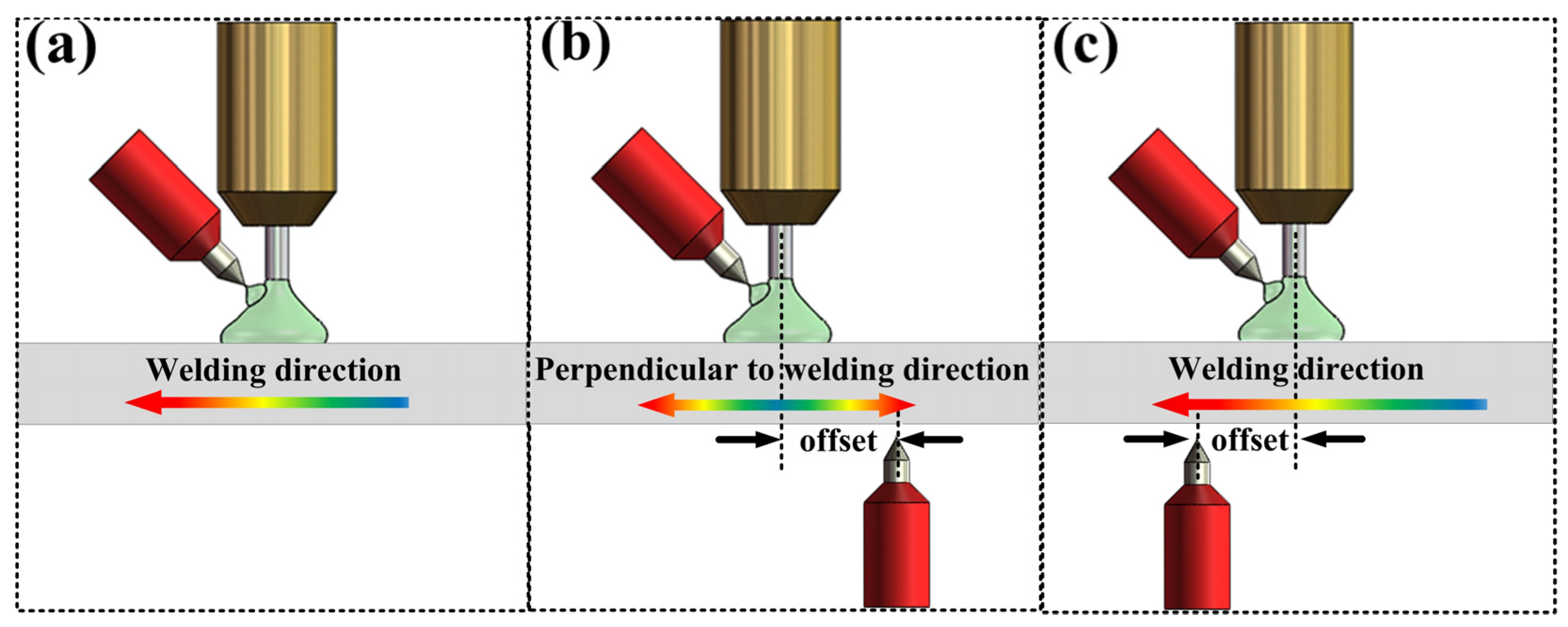
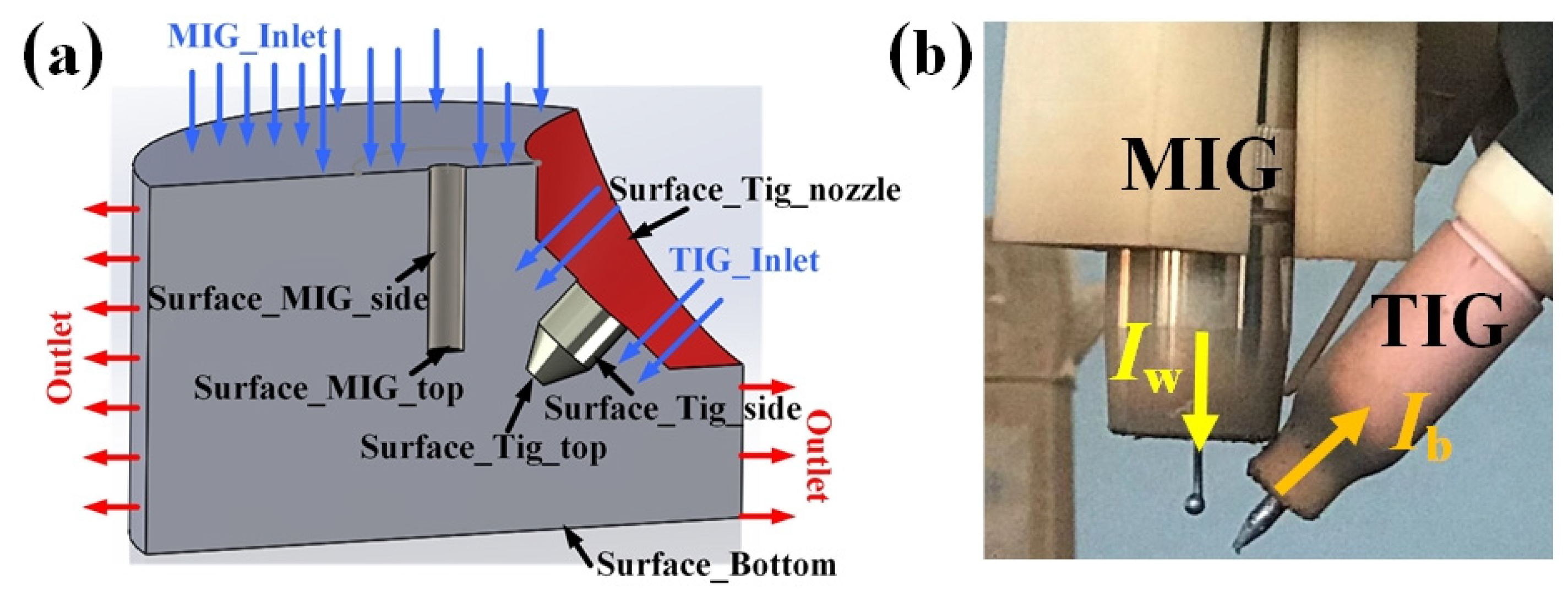




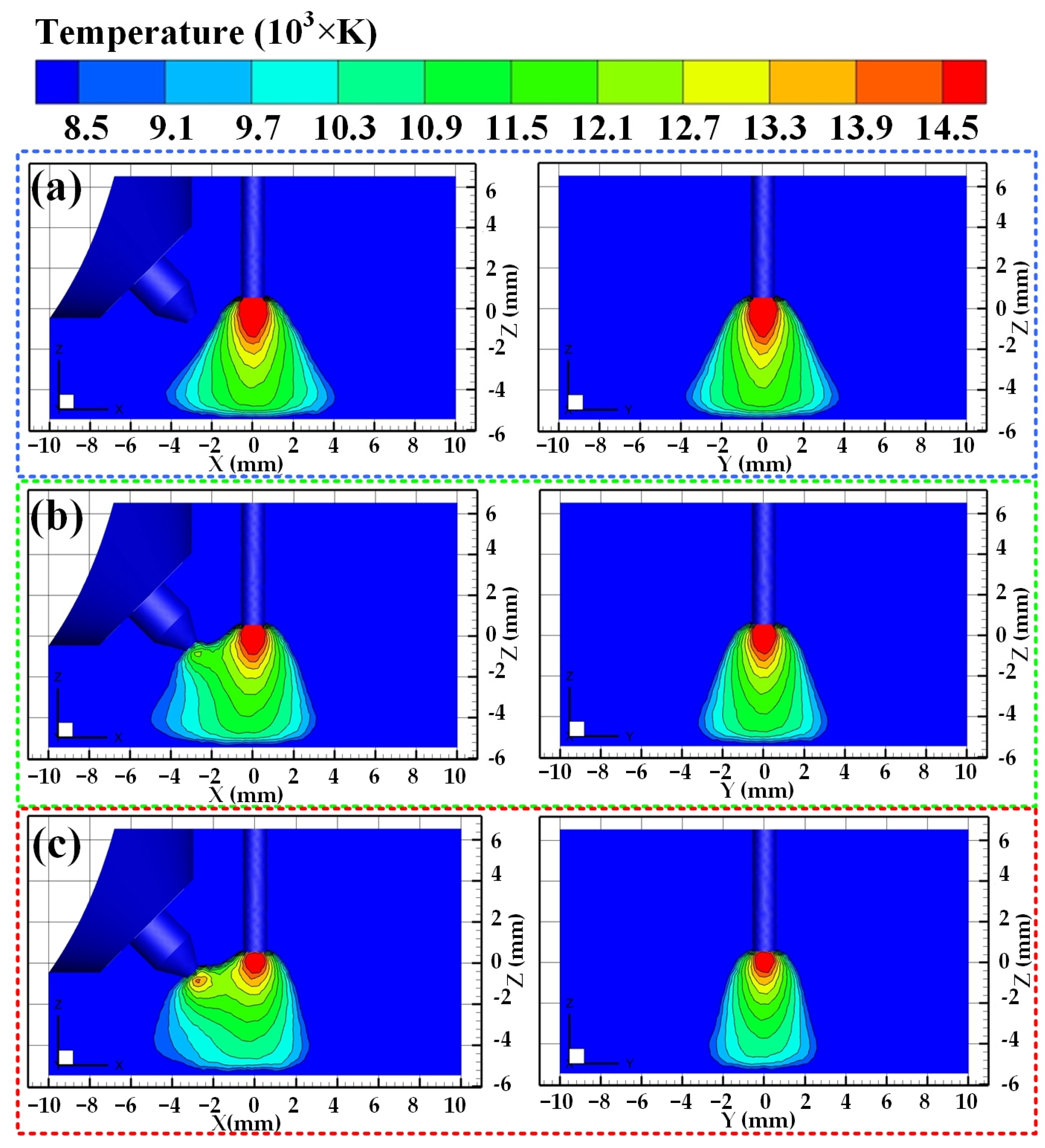



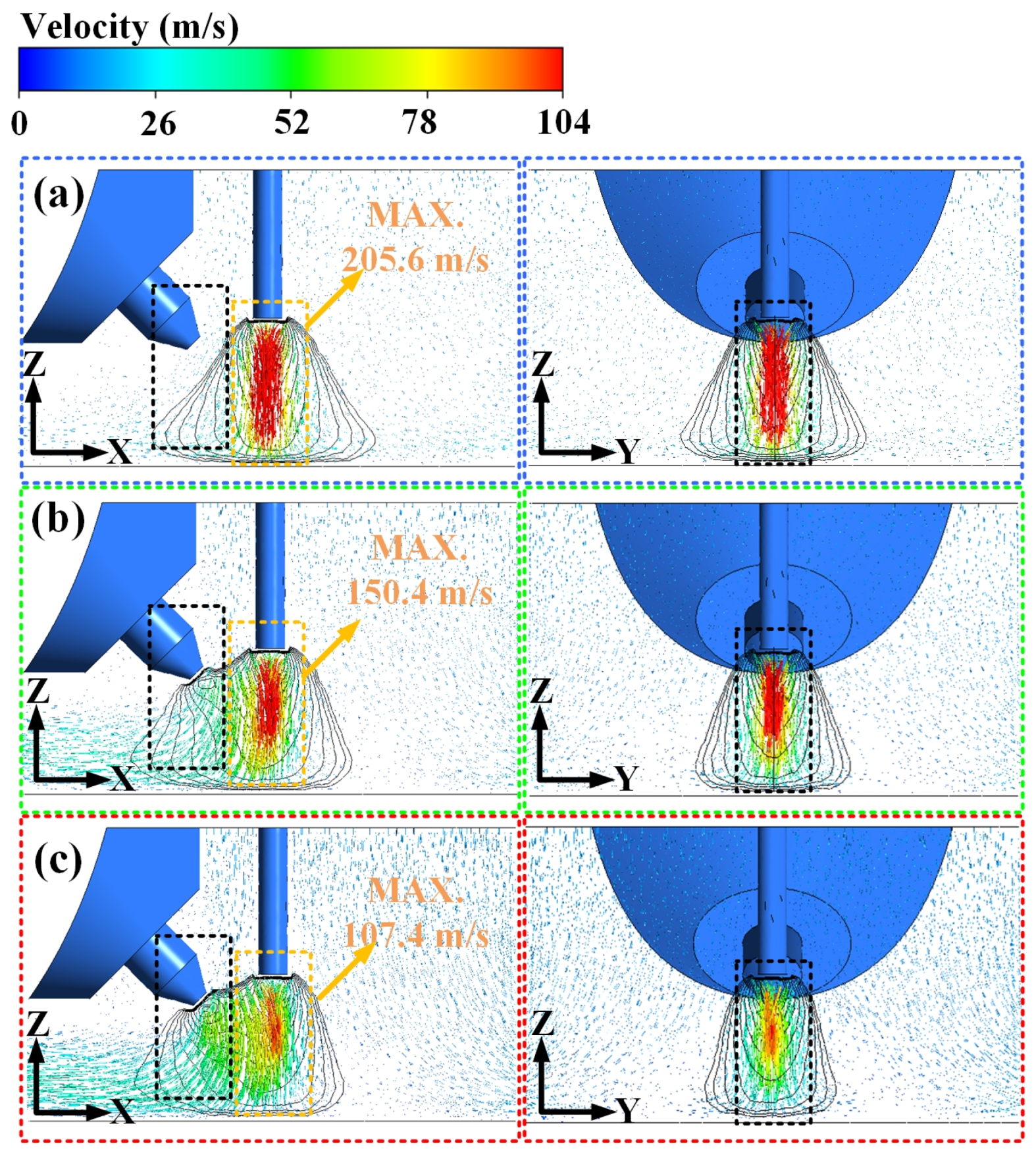


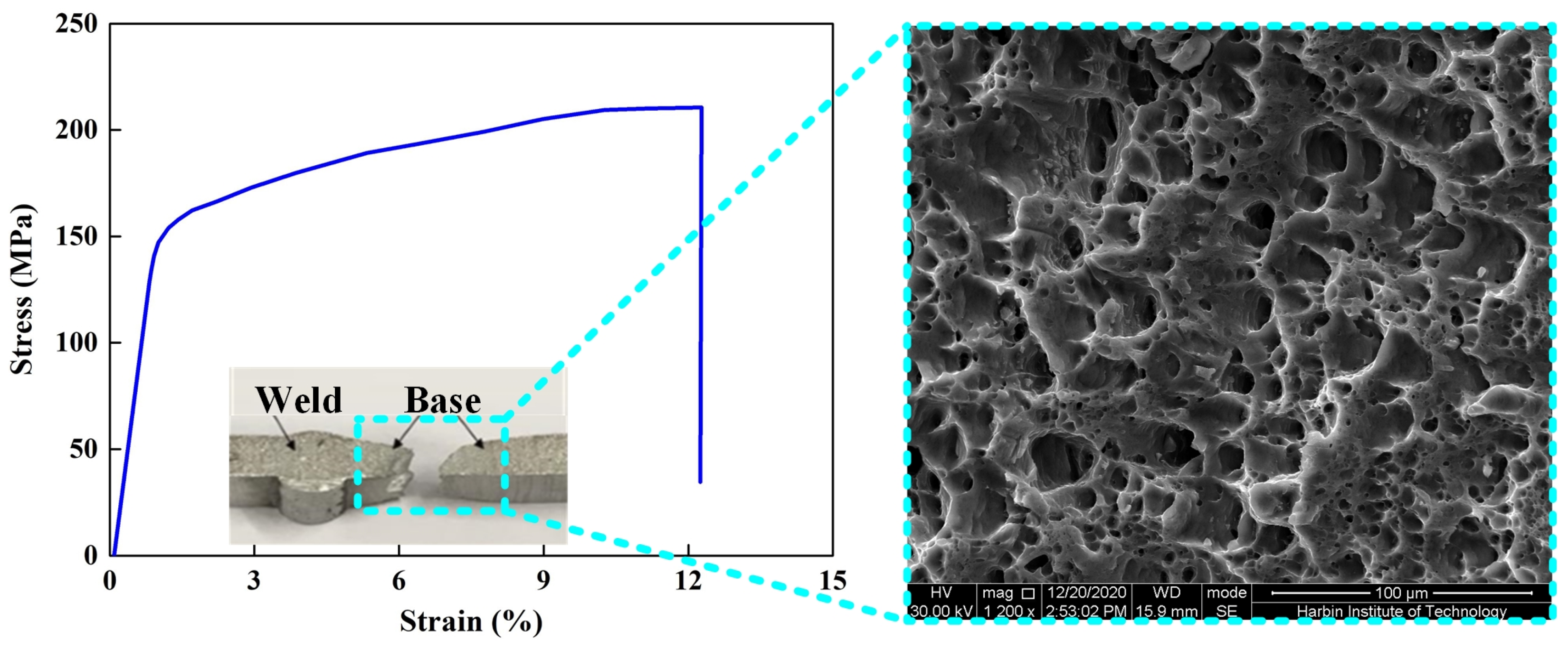
| Case | Iw (A) | Ib (A) | MIG-Gas (L min−1) | TIG-Gas (L min−1) |
|---|---|---|---|---|
| 1 | 130 | - | 15 | - |
| 2 | 110 | 20 | 15 | 5 |
| 3 | 90 | 40 | 15 | 5 |
| Base | Fe | Cu | Mn | Ti | Si | Cr | Mg | Zn | Al |
|---|---|---|---|---|---|---|---|---|---|
| 6061 | ≤0.7 | 0.15~0.4 | 0.15 | 0.15 | 0.4~0.8 | 0.04~0.35 | 0.8~1.2 | 0.25 | Balanced |
| Boundary Surface | Temperature (K) | Velocity (m/s) | Electric Potential (V) | Magnetic Potential (Wb m−1) |
|---|---|---|---|---|
| Outlet | 400 | 0 | ||
| Surface_Bottom | 1000 | - | - | 0 |
| MIG_Inlet | 400 | VMIG_shielding | ||
| TIG_Inlet | 400 | VTIG_shielding | ||
| Surface_MIG_top | 2000 | - | [32] | |
| Surface_TIG_top | 3000 | - | [32] | |
| Surface_MIG_side | 1000 | - | 0 | |
| Surface_TIG_nozzle | 1000 | - | 0 | |
| Surface_TIG_side | 2000 | - | 0 |
| λ | Experimental Results | Binarization | Calculated Results |
|---|---|---|---|
| 0 | 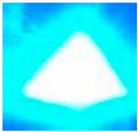 |  |  |
| 0.18 |  |  |  |
| 0.44 |  |  |  |
Disclaimer/Publisher’s Note: The statements, opinions and data contained in all publications are solely those of the individual author(s) and contributor(s) and not of MDPI and/or the editor(s). MDPI and/or the editor(s) disclaim responsibility for any injury to people or property resulting from any ideas, methods, instructions or products referred to in the content. |
© 2024 by the authors. Licensee MDPI, Basel, Switzerland. This article is an open access article distributed under the terms and conditions of the Creative Commons Attribution (CC BY) license (https://creativecommons.org/licenses/by/4.0/).
Share and Cite
Zhang, Z.; Wang, Z.; Miao, Y.; Hu, G.; Zhao, Y.; Liu, J.; Wu, Y.; Deng, Q. Experimental and Numerical Investigation of the Thermal and Force Regulation Mechanism of Bypass Coupling Double-Sided Arc Welding Based on 6061 Aluminum Alloy. Coatings 2024, 14, 161. https://doi.org/10.3390/coatings14020161
Zhang Z, Wang Z, Miao Y, Hu G, Zhao Y, Liu J, Wu Y, Deng Q. Experimental and Numerical Investigation of the Thermal and Force Regulation Mechanism of Bypass Coupling Double-Sided Arc Welding Based on 6061 Aluminum Alloy. Coatings. 2024; 14(2):161. https://doi.org/10.3390/coatings14020161
Chicago/Turabian StyleZhang, Zheng, Ziran Wang, Yugang Miao, Guangxu Hu, Yuyang Zhao, Ji Liu, Yifan Wu, and Qingwen Deng. 2024. "Experimental and Numerical Investigation of the Thermal and Force Regulation Mechanism of Bypass Coupling Double-Sided Arc Welding Based on 6061 Aluminum Alloy" Coatings 14, no. 2: 161. https://doi.org/10.3390/coatings14020161
APA StyleZhang, Z., Wang, Z., Miao, Y., Hu, G., Zhao, Y., Liu, J., Wu, Y., & Deng, Q. (2024). Experimental and Numerical Investigation of the Thermal and Force Regulation Mechanism of Bypass Coupling Double-Sided Arc Welding Based on 6061 Aluminum Alloy. Coatings, 14(2), 161. https://doi.org/10.3390/coatings14020161






